|
BACK IN THE MID-1960S, NOT LONG AFTER this writer arrived in Asia, I recall reading an issue of Consumer Reports that summarized the road test of a new Japanese minivan. At this time, three-wheeled trucks steered by handlebars were still a common sight on Japanese streets, and Fuji Heavy Industries' high expectations toward its new vehicle had apparently led it to attempt exports to North America.
The reviewer gave something less than a glowing recommendation. In an attempt at humor -- quite rare for this particular publication -- he summed up his feelings by writing: "It was a pleasure to squirm out of the Subaru, slam the door, and walk away."
But a decade later, gasoline prices were soaring in the wake of the Mideast war and suddenly Americans weren't laughing any more. They were buying Toyotas and Nissans and yes, even Subarus, mainly for their stingy fuel consumption, but also out of recognition that big was not necessarily better.
The gloating tone of the above-mentioned magazine article is no more to be found, at least about Japanese products. Now you are more likely to hear gasps of admiration, bordering on awe, as people ask, "How do they keep coming up with new ideas?" And "How do they do it at those prices?"
"If history teaches us anything," my friend Mark Colby of Colby Group International likes to say, "it's to never, never, ever underestimate the Japanese."
With the Japanese love for hierarchies, it shouldn't be surprising that making and ranking products designated "hitto" has become something of a fine science. This term "hitto" itself dates back to the early seventies, a period when the ownership of basic household goods like TVs, washing machines, refrigerators, et cetera, reached over 90 percent. Manufacturers, realizing that the days were gone when consumers would snap up virtually anything they offered, had to develop niche products while emphasizing greater convenience; smaller size, lighter weight, greater portability and -- for the first time -- the "fun" aspect of usage.
So in 1971 the Nikkei Ryutsu Shimbun, a thrice-weekly newspaper covering retailing and distribution, came up with the idea of announcing the years' hits in the product and service sectors by use of a sumo-style "banzuke" (ranking list). At the top came the East and West Yokozuna (grand champions), followed by Ozeki (champions), Sekiwake (junior champions), and so on, down through the ranks. The eagerly awaited list appears on the front page of the final issue each December.
A history of the Nikkei banzuke would confirm that while Edison's famous adage about genius being only 1 percent inspiration may indeed be true, there has been enough of the 1 percent to go around.
Take the employee of Mitsubishi Electric, a single fellow with no missus to sun his futon outdoors while he worked. Or warm it for him indoors before he came to bed. Miserable over having to crawl into chilly bedding each evening, he would direct warm air from his electric hairdryer to warm it up. One night, a light bulb went off in his head. He proposed his idea to his superiors, which led to development of the electric futon dryer -- a Yokozuna "hitto" of 1977 -- selling some 700,000 units that year alone. It has since become a standard household appliance.
The "hit" products that can generate long-term demand are destined to become naga-uri shohin -- goods like the 50cc Honda Cub scooter that, at least in terms of its outward appearance, hasn't changed since the 1950s. Kao's "Attack" mini laundry detergent appealed to housewives who shopped by bicycle and were intimidated by lugging home large boxes. Sony's Walkman and Asahi "Super Dry" beer come to mind as other examples of the hits that keep driving in runs.
Of course there are also nemureru shohin, literally sleeping goods -- automatic bread baking machines being a prime example. It seemed like a good idea at the time, but after a brief fascination, its owners realized that tasty bread could be inexpensively purchased. The machines wound up stored in the back of the closet.
Some "revolutionary" new products were destined to meet their evolutionary dead end in the first generation. The "EL Cassette," launched by several audio makers to span the gap between open-reel tape and cassette decks, was ignored by audiophiles. Three analog laserdisc formats coexisted at one time; only one -- the format promoted by Pioneer -- managed to survive for any length of time. Now, of course, the DVD has taken over. But there are indications that, as amazing as it is, this too, may be already be facing technological obsolescence. The future will be data delivered to your home via optical cable networks: think of MP3 for music, TV, movies, magazines, and books and you get the idea.
Japanese market researchers today have their eyes on males between the ages of 18 and 25 and single females up to their mid-thirties. They still live at home (articles in the vernacular media often refer to them as "parasite singles") and much of their paychecks go toward self indulgence in a myriad of forms. To satisfy these urges, designers and marketers rush new products to market -- motor vehicles, watches, and electronic gadgets for the fellows, and anything related to weight loss or epidermal preparations for the gals, with cellular phones and hair treatment products appealing to both.
The big-ticket items are becoming more exotic all the time, although plenty of really good products out there never quite make it. It is an unchanging axiom that people won't buy what they can't understand. At an appliance store a salesman once introduced me to a certain refrigerator model that was equipped with fuzzy logic. "Yuk," I said to the salesman. "Isn't that the green stuff that forms on the surface of cheese, baked goods, etc., when you wait too long before eating it?" He proceeded to tell me that this particular model, actually equipped with "neuro-fuzzy" logic, would adapt itself to my lifestyle. "You mean it pigs out on frozen pizzas and gains weight?" I asked incredulously. He chuckled knowingly and explained that since food freshness requires the interior to maintain a constant temperature, the unit "learns" which times of the day I open and close the doors most frequently, and anticipates these activities by pre-chilling the interior beforehand. And since I seldom raid the refrigerator in the hours before dawn, it loafs until just before breakfast time.
I went with a low-tech model, a Sharp whose doors had twin hinges that allowed its doors to be opened from either the left or right side. Seeing, after all is believing.
 Time Can Millenium Cup Noodle Time Can Millenium Cup Noodle
A limited edition "cup noodle" to mark the millennium. Who would have ever thought of it? Well, Nissin did. And while the product itself can hardly be described as unique, I'm truly impressed by the effort that went into the design and packaging. You see, ordinary instant noodle products have a shelf life of about five months. But appropriate for the occasion, Nissin put theirs inside a "time capsule," a tin and aluminum container, that will keep the noodles in edible condition for a full decade. So 10 years from now, assuming you can find a potable water supply, you can break them out and enjoy a real feast. (OK, let's not get carried away.) Just 1.5 million of the "Time Cans" will go on the market at ¥200 each. Get 'em while supplies last and you'll have at least one less meal to plan in 2010.
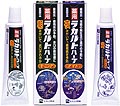 Rakaruto herb toothpaste Rakaruto herb toothpaste
SS Pharmaceuticals no doubt brought smiles of approval to the faces of the nation's dental practitioners when it announced the sale of Rakaruto Herb toothpaste. The product is packaged as a set of two tubes, marked, respectively, "Morning" and "Night." The ingredients of the former include rosemary, sage, and the essence of five other herbs designed, no doubt, to get the smell of coffee off your breath. (As for the latter, don't ask.) Earlier this year, you may have caught actress Miki Sakai flashing her pearly whites in the TV commercial for this product. The targeted market is said to be adolescent females, but it makes a great conversation piece for your overnight guests. The set of two color-coded tubes (green for morning and blue for evening), goes for ¥800 to ¥1,200, depending on tube size.
 X-NS1 mini component system X-NS1 mini component system
No space in the room for an audio rack? Pioneer's X-NS1 mini-component system is designed for wall mounting. The CD/tuner is only 66 millimeters (about 2.5 inches) thick, making it so unobtrusive you can mount it almost anywhere and operate it by remote control. Round out the system with an optional cassette deck, MD recorder or CD recorder (for dubbing CDs), all of which boast equally compact dimensions. Separate pre/main amplifier puts out 30 watts per channel. The basic ensemble, including a three-speaker system with 16cm subwoofer, goes for ¥49,000.
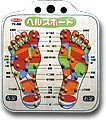 The Health Board The Health Board
According to a recent issue of Nikkei Business, products that put you in touch with your acupressure points have been booming. Women are said to account for 80 percent of the purchasers of such products, although the males in the household are also known to put them to use. Department stores carry a wide assortment of such goods, which are priced anywhere between ¥500 to ¥6,800. The Health Board (¥1,500), from Tokyo Kikaku Hanbai, is one such item. Just align your feet on the areas shown and it will stimulate the tsubo -- to lower stress, enhance sleep and improve thyroid functions. A good gift item for the seniors on your shopping list, along with warming devices.
 Custom baseball glove Custom baseball glove
Determined to present "the cutting edge of sports technology," sports equipment manufacturer Mizuno in August organized a press gathering to propose its visions for products two decades from now. Even assuming the baseball itself remains unchanged, the outfielder's glove shown in the photo, thanks to the use of super-light resin material, weighs just 350 grams. It will be custom-fit to each player's hand, and will plug into an inner glove, flexing with each finger to enable a fit so natural as to function as an extension of the player's hand. Also on the horizon: improvements in catcher's protective wear; bats with foul tip protector shields; and shoes with electronic "laces," whose cleats can be programmed to each player's body weight and batting stance. Still needed: a death-ray device for fans to blast the home plate umpire.
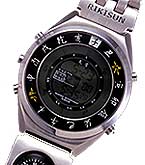 Zodiac wristwatch Zodiac wristwatch
For the man who has everything -- except harmony with the cosmos -- we recommend the Kigaku Tokei. This wristwatch will tell him how to do everything, from what day to marry to how to arrange his living room furniture. On the outer dial are 12 characters symbolizing the hoary animals of the Chinese zodiac, i.e., ox, tiger, dragon, snake, sheep, monkey, boar,
et cetera. Along with the time, its LCD digital display will tell you which of the rokuyou today is, great for planning weddings, funerals and board meetings. The band also incorporates a magnetic compass. You never need fear unruly fengshui again: may the force be with you! Available for ¥28,000 from Original K.K.
 Toy tran camera Toy tran camera
Nothing made me more aware of what a deprived childhood I led until the announcement for "TV de Asobou! Boku wa Pura Reeru Untenshu." This new item from Tomy, which has been in the model railway business since 1959, consists of a tiny camera mounted aboard a locomotive of a model train. Using an infrared transmitter, the camera projects its images to the home TV screen, giving the scenes viewed by a railway engineer as he passes over bridges, through tunnels and halts at rail station platforms. The controller can also be used to control forward and reversed speed. (Writer sighs audibly and pours another beer.) The set goes for ¥12,800.
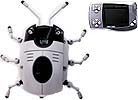 WonderBorg WonderBorg
To be honest, this writer has never really been able to understand the Japanese fascination for bugs. When Sony released its AIBO dog robot last year, I should have known it would just be a matter of time before someone came up with the equivalent of a mechanical cockroach. Enter the WonderBorg, an electronic beetle assembly kit designed to bring joy into the life of every nerd who hugged and petted a disgusting creepy-crawly. Using Bandai's WonderSwan game machine, you can program its internal cartridge using infrared control. The first shipment of 1,000 offered in June (¥12,000 each) sold out within eight hours, and they remain in short supply. Pardon me while I reach for the RAID. Can be viewed at: www.swan.channel.or.jp/borg
 Clip-on 30-GB video recorder Clip-on 30-GB video recorder
Neither tape nor disc, the "Clip On" from Sony is a new type of video recorder with a 30-gigabyte hard disk drive. It records images and sound for up to 20 hours
(5 hours in the HQ mode) and has G-Code capability that enables automated selection of programs for recording. Index search uses thumbnails of scenes, from which the viewer can make quick selections. Viewing time can be speeded up by 50 percent while enabling the sound track to remain comprehensible. I like the split-screen recording monitor function that lets you continue to watch another program and be able to check the recording in progress. The price: ¥198,000; expandable by 30 GBs for an additional ¥40,000.
 MS2000S vibrating alarm bed MS2000S vibrating alarm bed
After the seismic activity that has plagued Tokyo during the past summer months, this writer has lost enough sleep, thank you. But for those who find it next to impossible to get up with the chickens, France Bed presents MS-2000 Sup, the sleeping platform that won't take no for an answer. At the preset time, its built-in vibrator commences shaking, increasing intensity in six increments until the sleeper feels like a vodka martini -- shaken and stirred. Priced at ¥75,000, the mattress is also equipped with an audible alarm.
 VC-V1 vertical VHS VC-V1 vertical VHS
I've got to hand it to the designers at Sharp: their TV and VCR ensemble tricked me into thinking I'd walked into the computer department by mistake. The VHS unit (VC-V1) is first of a new generation to be styled for vertical arrangement and may take some getting used to, but it saves on space and, since it uses the S-VHS format, provides superior definition on its companion 15-inch TV, the 15C-FM1. Perfect for small pads or as a second unit for the bedroom. Definitely worth considering if you don't mind owning something that will become obsolete after 2010.
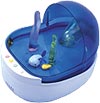 Water Looper Mutsu Water Looper Mutsu
"Water looper Mutsu" is not your everyday plastic fishy toy. The two finny critters provided by Toymaker Tomy incorporate electromagnets and ordinary magnets that interact, causing them to swim about realistically in their watery home. Photoelectric sensors also cause the fish to alter their behavior in response to light. Press the button on the other edge, and the tank dispenses "food" -- iron pellets which the fish actually swim up and "eat." And if that's not enough, they also engage in synchronized swimming in response to music. Power is supplied by three type "D" batteries. I actually plan to buy this Valium substitute for my den. How can I go wrong for ¥3,980?
|


 Time Can Millenium Cup Noodle
Time Can Millenium Cup Noodle Rakaruto herb toothpaste
Rakaruto herb toothpaste X-NS1 mini component system
X-NS1 mini component system The Health Board
The Health Board Custom baseball glove
Custom baseball glove Zodiac wristwatch
Zodiac wristwatch Toy tran camera
Toy tran camera WonderBorg
WonderBorg Clip-on 30-GB video recorder
Clip-on 30-GB video recorder MS2000S vibrating alarm bed
MS2000S vibrating alarm bed VC-V1 vertical VHS
VC-V1 vertical VHS Water Looper Mutsu
Water Looper Mutsu


